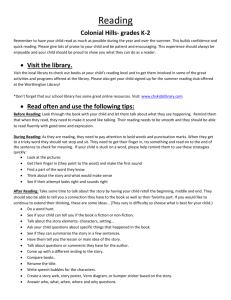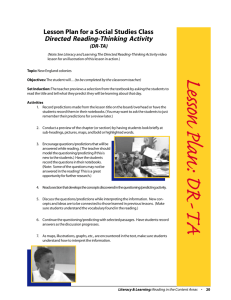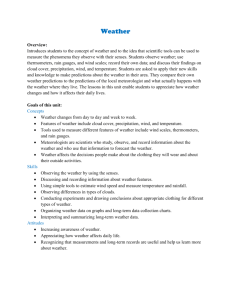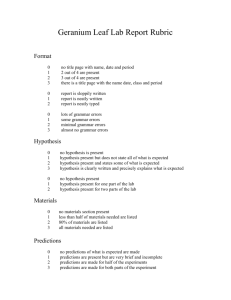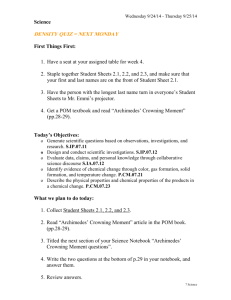This lesson written by: Rebecca Freeman Lesson Grade: K Lesson
advertisement
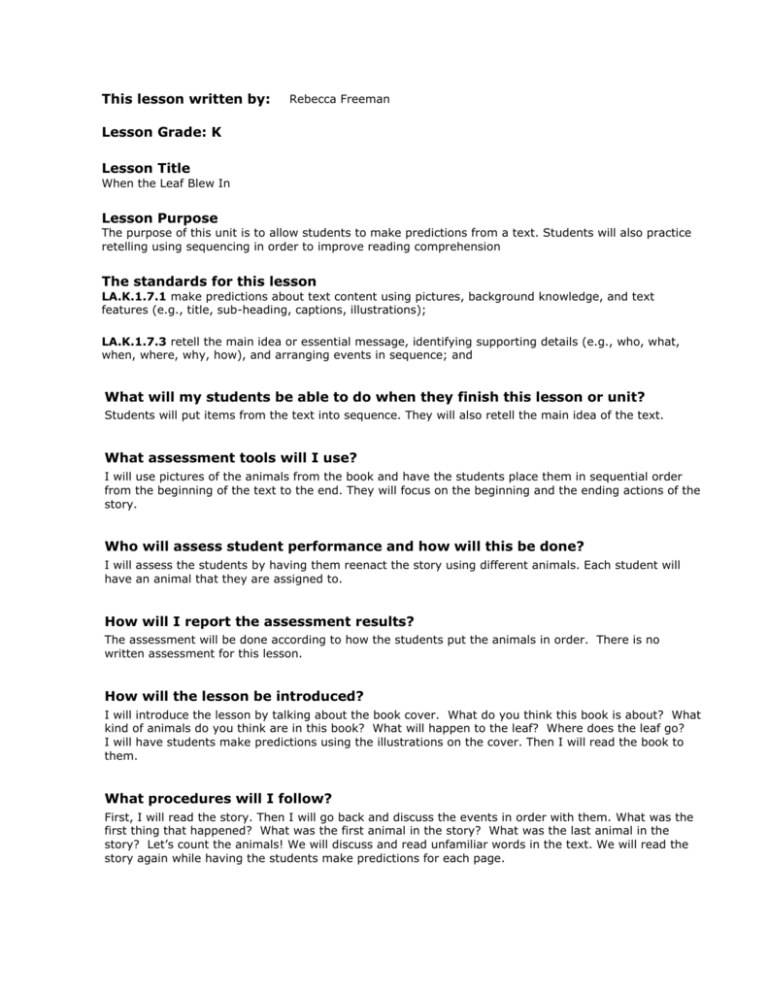
This lesson written by: Rebecca Freeman Lesson Grade: K Lesson Title When the Leaf Blew In Lesson Purpose The purpose of this unit is to allow students to make predictions from a text. Students will also practice retelling using sequencing in order to improve reading comprehension The standards for this lesson LA.K.1.7.1 make predictions about text content using pictures, background knowledge, and text features (e.g., title, sub-heading, captions, illustrations); LA.K.1.7.3 retell the main idea or essential message, identifying supporting details (e.g., who, what, when, where, why, how), and arranging events in sequence; and What will my students be able to do when they finish this lesson or unit? Students will put items from the text into sequence. They will also retell the main idea of the text. What assessment tools will I use? I will use pictures of the animals from the book and have the students place them in sequential order from the beginning of the text to the end. They will focus on the beginning and the ending actions of the story. Who will assess student performance and how will this be done? I will assess the students by having them reenact the story using different animals. Each student will have an animal that they are assigned to. How will I report the assessment results? The assessment will be done according to how the students put the animals in order. There is no written assessment for this lesson. How will the lesson be introduced? I will introduce the lesson by talking about the book cover. What do you think this book is about? What kind of animals do you think are in this book? What will happen to the leaf? Where does the leaf go? I will have students make predictions using the illustrations on the cover. Then I will read the book to them. What procedures will I follow? First, I will read the story. Then I will go back and discuss the events in order with them. What was the first thing that happened? What was the first animal in the story? What was the last animal in the story? Let’s count the animals! We will discuss and read unfamiliar words in the text. We will read the story again while having the students make predictions for each page. What activities will my students complete? Students will act out the story using the assigned animals. –I am going to pass out the animals that are in the story. When I read the story, go stand near the person that you are supposed to follow. For example, if the spider landed on the owl, then spider is first then the owl will be next. We will get in the order of the animals in the book. You can act out what they did, too! They will then switch animals with each other and see if they can get in order according to the sequence of events. How will you summarize the lesson? At the end of the lesson, I will discuss with the students important information about the text. This will include the title of the book, the characters, and the sequence of events. What was the first thing that happened? Who was the first animal? Who was the animal that kicked the bucket? What did the rooster do? What instructional materials will I use for this lesson? The materials for this lesson are the book 'When the Leaf Blew In', and the animals from the story printed on paper. Each animal has the name printed below it for word recognition. We will go over the animals, what they are, and what the words say at the bottom. Reflection: (1) What evidence can you cite that demonstrates your students did or did not meet your objectives? When we reenacted the story, some students were able to get in place right away. Others did not remember which animal was first, etc. After telling the story again, they were able to catch on and started to remember the events in sequence. (2) (a). Elaborate on specific things that you did that resulted in student learning. I would read a page in the book –When the spider landed on the owl….” And I would ask the students what did the owl do? Before turning the page. I would let them guess. We did that for each page, a different page each time we read the story. (b). Explain why what you did was effective. It allowed the students to make predictions. My questions promoted them to think about what happened next. There were key elements in the pictures that I pointed out that they could guess. If the frog leaped into the water, on the page, there was a picture of the edge of the water. (3) (a). Elaborate on specific things that you would change that would improve students learning if you were to teach this lesson again. After teaching the lesson, I felt that there were too many events to follow. I noticed this in the first part of the lesson so I started putting it into sections. It was too much for them to remember. If teach this lesson again, I will have students draw pictures of the events or to pick one event and draw it and describe what they did and what happened next. (b). Explain why you think something didn’t work and why your change would make it successful. Having the students name each animal in sequence was difficult because there were so many. There wasn’t a beginning, middle, and end. Having them draw a picture and describe what happens next would break it down to something smaller that they could remember.


